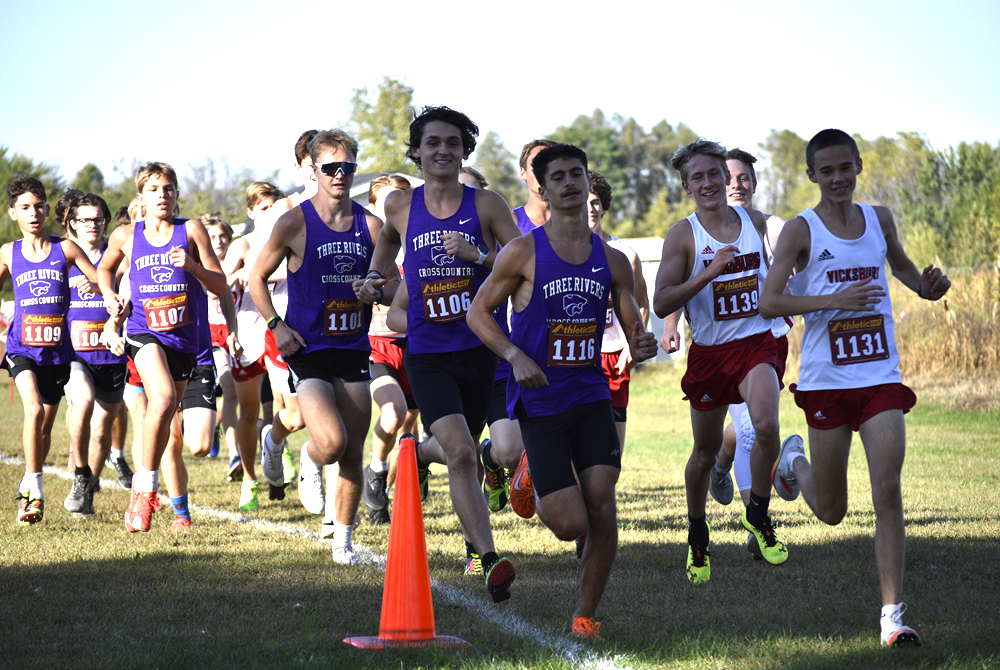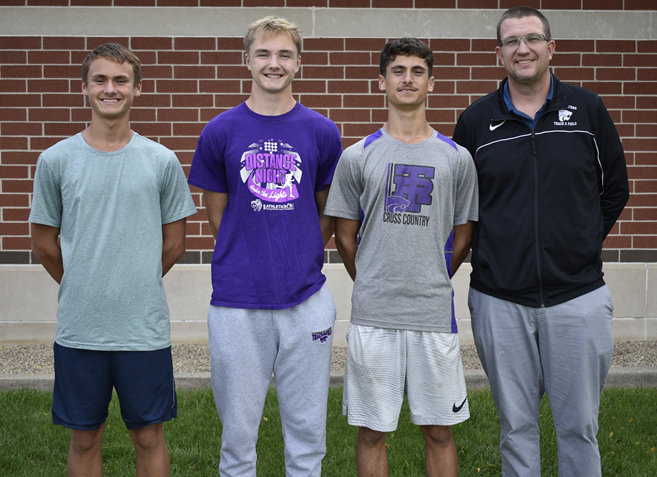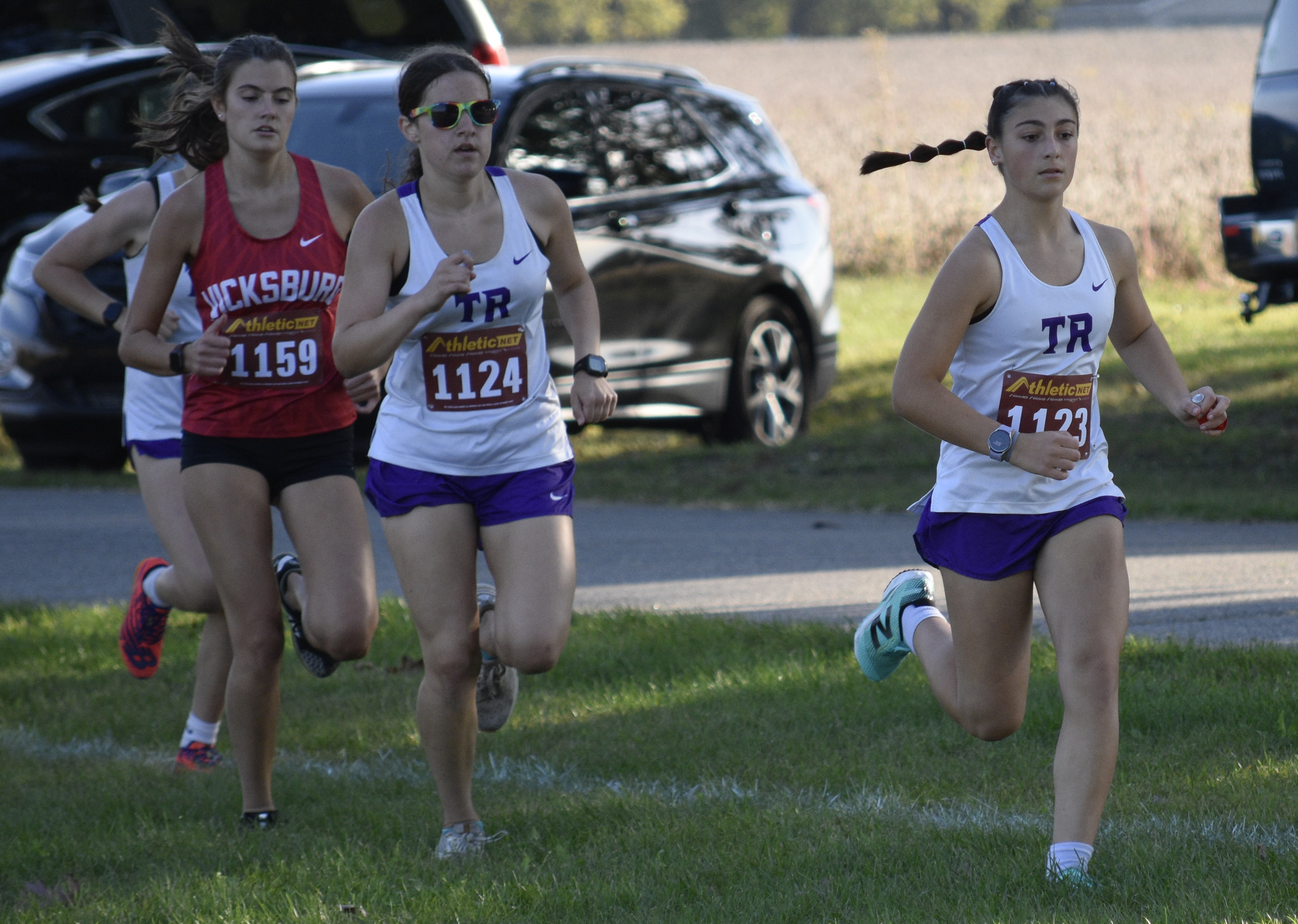
Major Goal Accomplished as Three Rivers Racers Continue to Accelerate
By
Scott Hassinger
Special for MHSAA.com
October 8, 2024
THREE RIVERS – Sulley Zietlow and his teammates on the Three Rivers boys cross country team discussed their goals for the 2024 season prior to starting an early-evening workout back in June.
 With several experienced returners, coach Jason Muckel and his Wildcats set the bar high for success this Fall.
With several experienced returners, coach Jason Muckel and his Wildcats set the bar high for success this Fall.
One of Three Rivers' preseason goals was to end Otsego's lengthy Wolverine Conference dual-meet winning streak.
The Wildcats quickly circled Tuesday, Sept. 17, as an important date on this fall’s schedule.
"Before the season began, we knew we were going to be running Otsego on our home course. We built our training plan around that race and made sure that our kids were ready to go," Muckel said.
Competing on its hilly home course at Meyer-Broadway Park, Three Rivers edged Otsego 24-31 thus ending the Bulldogs' 68-meet winning streak dating back to 2014.
Otsego, the 2021 Lower Peninsula Division 2 champion, has long been a state power under longtime head coach Steve Long. The Bulldogs have produced several talented runners, including 2018 individual Finals champion Alex Comerford, who went on to run at Syracuse University.
"I give Otsego a lot of credit for what they've done. Steve has built an incredible program. I have a lot of respect for him and his runners,” Muckel said. “He's helped me a lot here and there over the last few years, and I've learned a great deal from him."
Three Rivers, Plainwell and Otsego are currently tied for first in the league at 4-1 with two league duals plus next week's Wolverine Conference Meet in Otsego remaining. The Wildcats will need to win the league meet to earn an outright league title.
Zietlow, a three-time Finals qualifier, holds down Three Rivers' No. 1 spot and is also the top runner in the conference. The Wildcats qualified for the Finals as a team at the end of his freshman and junior seasons. He also qualified his sophomore year as an individual. As a junior he placed 52nd in LPD2 with a time of 16:18.9.
"Sulley is the top runner in our league and is beating the field by 30 or 40 seconds. He's gritty, hardworking, does whatever I ask of him and is the most committed runner I've ever had. He crushes everything he does," Muckel said.
Zietlow, who plans to continue his education and running career at Cornerstone University, ran a lifetime personal-best time of 15:52.4 in late August at the Under the Lights Invitational at Grand Rapids South Christian. He bested the field in the home victories over Otsego and Edwardsburg with a time of 16:12, his fastest on Three Rivers' home course.
"That (Otsego) win was very exciting and memorable,” Zietlow said. “This is the best team we've had here in a while. Our depth is good, and we want our pack time to be within a minute by season's end. I think we could take Top 10 in the state if reach our potential. The commitment, drive and positivity of our team is improved over last year."
 Winning a conference title and qualifying again for the Finals are both reachable goals for he and his teammates.
Winning a conference title and qualifying again for the Finals are both reachable goals for he and his teammates.
"I've ran for the last 493 days, and I've worked extremely hard to get where I am at this point. Our team is in good shape," Zietlow said.
Junior Charlie Brauer is Three Rivers' No. 2 runner.
"Charlie has made huge strides after fighting injuries the past couple years,” Muckel noted. “His CrossFit training and commitment to running a lot of miles over the summer have helped him make big gains. He's solidified himself as our number two runner and has a shot to finish among the top five or six in our conference."
Brauer clocked a personal-best of 16:35.03 at the Otsego Invitational, where Three Rivers took fourth.
"I'm kind of surprised to be our No. 2 runner,” Brauer said. “I do CrossFit training and that's helped me improve my kick along with my overall fitness. The last mile is the best part of my race."
Juniors Reece Howes (17:12) and Jonah Zietlow (17:18), Sulley's younger brother, have alternated as the Wildcats' Nos. 3 and 4 runners. Classmates Trey Hall (18:26) and Dontrel Taylor (18:26), along with freshman David Kore (17:48) round out Three Rivers' top seven.
"David is starting to race well against the older guys and can hold his own,” Muckel said. “If we're able to do some special things down the stretch here, a lot of that will depend on the performances of David, Reece and Jonah. Our sixth, seventh and eighth guys are working hard so they can step up if we incur an injury at some point."
Jonah Zietlow outlined his goals for the Wildcats the remainder of the season.
"It just depends what day it is and who steps up for us. We push one another to go faster,” he said. “If one of us isn't having the best race, we all work harder to make up for it.
“I'd like to solidify that No. 3 spot and get my time down under 17 minutes by the end of this season. I have a pretty strong kick, so that's a big key for me."
In the dual against Otsego, Zietlow played a key role by earning fourth overall while outpacing the Bulldogs' No. 2 and No. 3 runners after catching them with about 600 meters remaining.
He noted the team’s level of dedication is the highest he's seen since joining the program as a freshman. The top five runners for Three Rivers all logged more than 500 miles during the summer.
Muckel is pleased with the times his runners are posting, especially now since the Wildcats have started competing on some different kinds of courses and terrain.
"Up until the last week or two our times weren't quite as good on paper as we wanted them,” Muckel said. “That's because we were running some more difficult courses. Now as we get into running some flatter courses, our guys are excited to be able to show off their speed a little.
"In practice we do a workout called core sections, which is designed to split our course into sections and attack one of them at a time. We've done some very intentional workouts to prepare for races like our home course. I always talk to our kids about getting a good mileage base in the summer. Then we enter racing mode as the season starts. Now we're in championship gear, where we try to perfect our craft."
Three Rivers won its own Hill Climb Invitational followed by runner-up finishes at the Under The Lights and Battle Creek Lakeview invitationals, a third place at the Southwest Michigan Robuster Invite and a fourth-place finish at the Otsego Invite.
"My philosophy as a coach is to take our team to those difficult meets. We might take our licks early in the season, but it prepares us for the races that matter the most later on and builds character," Muckel said.
 Three Rivers frequently splits its boys practices up into two sessions.
Three Rivers frequently splits its boys practices up into two sessions.
"Each of our kids are committed,” said Muckel, who is in his third season coaching both the boys and girls Three Rivers teams. “As a coach I don't like to do an eight or nine-mile workout. Instead, we have our boys come in for a morning run and return in the afternoon for a five or six-mile practice. By breaking up those workouts, it’s easier on the body and keeps us healthier throughout the season.
"When I took over the program, there were some bad habits we had to break out of that first year. I basically have the boys run seven days a week now, which is something they weren't willing to do in the beginning.”
An individual goal-setting strategy has become a fun motivator.
“I ordered little mini records, and each kid is required to set goal-times and write them down. When they break that time during the season they get to break that record in half,” Muckel said. “These kinds of things have really helped the kids buy into our program and take ownership of it.”
***
After graduating nine seniors last year, Muckel is rebuilding his girls squad. His top two runners Brynn Copenhaver and Lillie Kerr are only sophomores.
"We have a young core of runners in our top of the pack who are learning to race. It's a talented group, and I believe we'll see a lot of cool things out of them in the next few seasons," Muckel said.
He noted several activities his boys and girls teams enjoy together as part of building a memorable all-around experience in the sport. Among those is the program’s summer camp involving both teams, which included four days this past offseason at Warner Camp in South Haven.
“Bringing our boys and girls teams together has also been really beneficial,” Muckel said. “While we are (at camp) we participate in a high ropes course, water ball and other activities and we get our workouts in as well. We use that time to solidify the team culture and do team-building tasks.”
 Scott Hassinger is a contributing sportswriter for Leader Publications and previously served as the sports editor for the Three Rivers Commercial-News from 1994-2022. He can be reached at [email protected] with story ideas for Berrien, Cass, St. Joseph and Branch counties.
Scott Hassinger is a contributing sportswriter for Leader Publications and previously served as the sports editor for the Three Rivers Commercial-News from 1994-2022. He can be reached at [email protected] with story ideas for Berrien, Cass, St. Joseph and Branch counties.
PHOTOS (Top) Three Rivers and Vicksburg runners take off at the start of the boys race last week at Indian Lake Nazarene Camp. (Middle) Pictured from left are Three Rivers juniors Jonah Zietlow and Charlie Brauer, senior Sulley Zietlow and Three Rivers head cross country coach Jason Muckel. (Below) Lillie Kerr, right, and teammate Gabby Kilbourn lead Three Rivers in the girls race against Vicksburg last week. (Photos by Scott Hassinger.)

MHSAA Vault: MIS Rose to Challenges to Host 2020 LP Finals
By
Rob Kaminski
MHSAA benchmarks editor
November 12, 2021
The “MHSAA Vault” features stories from past publications and other documents in the MHSAA Library. This issue takes a look at the MHSAA Cross Country Finals at Michigan International Speedway, which celebrated 25 years in 2020 – although it was an event that nearly didn’t happen last fall …
In 1996, the MHSAA and Michigan International Speedway began a partnership the changed the course of the Lower Peninsula Cross Country Finals – quite literally.
The land in and around the track at Brooklyn would host the Finals for all classes of runners in one place on one day, an annual festival of nearly 2,000 runners competing for the MHSAA’s top honors.
Even skeptics – and there were several among running purists who thought the course was too flat, for example – can’t deny the results.
Finals attendance nearly doubled in that first year, and crowds in excess of 10,000 have enjoyed a day of racing several times, including a record 12,153 in 2011.
Enthusiastic crowds were the norm in recent years, with 11,232 in 2017, and nearly 11,000 in 2018 (10,989) and 2019 (10,873).
In fact, attendance failed to reach at least 8,000 only twice since the move to MIS.
Of course, last year was an exception, when attendance was limited to 1,000 spectators per session due to the COVID-19 Pandemic. Fans also were restricted to the grandstands rather than following the action throughout locations on the course.
To reduce the number of runners in each race, the event was spread over two days, with each Division being run in two separate “sections” with times then combined at the end to determine team and individual champions.
While not ideal, the end result was another year of fantastic efforts at MIS – both from student-athletes and those behind the scenes.
“Even at the last hour, less than a week ahead of the Finals, we were closer to not having the Finals than we were to having them,” said MHSAA Assistant Director Cody Inglis, who coordinates the cross country postseason. “Rumors and challenges of mandated shutdowns, testing and other requirements were being discussed and caused a lot of unknowns. Even at the Regional level, we had schools, Regional courses and hosts shutting down their facilities; we had to relocate four Regionals 48 hours prior to race times. That scenario just could not happen at the Finals level where far more runners and much more travel would be involved.”
Among the many last-minute hurdles was the edict from NASCAR – which owns MIS – that all persons on site be temperature checked upon entry. That meant securing thermometers that were easy to operate in short order, along with personnel necessary to conduct the readings.
The attendance limitations certainly helped to implement the temperature screening, but brought their own issues.
“Limiting spectators was not a popular decision, but it really was the only way to have a race,” Inglis said. “We were taking direction and working with policies and protocols from the MDHHS, the Governor’s office, Lenawee County Health Department, MIS and NASCAR.”
Part of the solution was to utilize the grandstands as a “barrier” between participants and spectators. The reduced number of fans were dispersed over thousands of seats while still allowing them the chance to watch their student-athletes compete.
“It wasn’t the same, it wasn’t easy or perfect, but it was what we had to do to have a race,” Inglis said. “Separating the Finals into two days and different sections also allowed us to spread out the event and limit the number of people on site at any one time. This was a key part of the plan and worked well even though it separated races within a Division.”
The MHSAA, MIS and the cross country community never lost focus of the main goal: a culmination of the season for the student-athletes, who deserved something last year more than ever. And, more than ever, MIS once again displayed its advantage as a venue that could adapt to the fluid nature of the times to pull off the event.
“There were some thoughts of using four different sites, but as we learned during the Regionals, the climate of things was so tenuous from one area of the state to another that we couldn’t be 100-percent certain that there wouldn’t again be last-minute cancelations,” Inglis said. “MIS was wonderful to work and collaborate with, and was the best option to get it done. It was never mentioned once publicly about the possibility of not having the Finals – only how we could best do it under uncharted conditions.”
The moving parts and ever-changing scenarios created more complexity than ever in finalizing a season, but every decision was made with the complete desire to conduct the Finals as close to normal as possible.
“I firmly believe that a finish to the season, no matter the differences in race formatting and fan experience, was something everyone would have taken when the season began in August,” Inglis said.
Indeed, the finish line in Year 25 at MIS might have been the most gratifying of them all.

